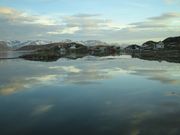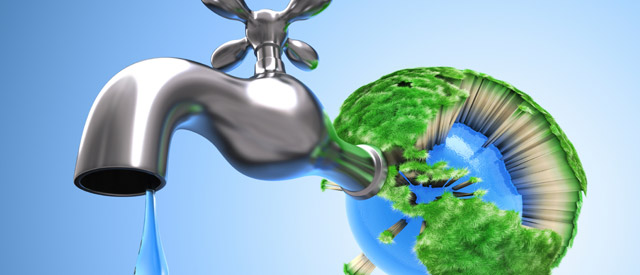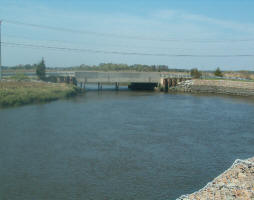 Arab Region Atlas of Our Changing Environment: First Report of its Kind Uses Satellite Images to Track Land-use Change, Urban growth and Shrinking Water Bodies
Arab Region Atlas of Our Changing Environment: First Report of its Kind Uses Satellite Images to Track Land-use Change, Urban growth and Shrinking Water Bodies
This is one of the most important publications in 2013. The 'Arab Region Atlas of Our Changing Environment' examines environmental change across the region, using a combination of on-the-ground photographs, current and historical satellite images, and extensive scientific evidence. The Atlas illustrates the pace of environmental change, including land-use change, urban growth, degradation of marine and coastal areas, altered hydrology and shrinking water bodies, loss of habitats and the impacts of climate change.
The pace of environmental change in the Arab region may be faster than in the rest of the world due to growing populations and increasing environmental pressures, according to a new report released today.
The United Nations Environment Programme (UNEP) and the Abu Dhabi Global Environmental Data Initiative (AGEDI), supported by the Environment Agency – Abu Dhabi (EAD) released The Arab Region: Atlas of Our Changing Environment.
The Atlas examines the environmental change that has taken place at more than 80 locations across the Arab region, using a combination of on-the-ground photographs, current and historical satellite images, with a narrative based on extensive scientific evidence.
“Before-and-after” studies in the atlas clearly demonstrate the pace of development in the region, offering compelling examples of wide-ranging environmental change, including land use change, urban growth, degradation of marine and coastal areas, altered hydrology and shrinking water bodies, loss of habitats and impacts of climate change.
The Atlas images serve to highlight the distinctive environmental circumstances and challenges faced in the Arab region, from limited freshwater resources, rapid urbanization, depletion of natural resources, and the vulnerability of many Arab settlements to environmental risks and natural disasters.
For example, water scarcity is a key environmental issue in 19 of the 22 countries. Very low and highly variable annual rainfall makes the region particularly vulnerable to climate change impacts, and per-capita water availability is expected to halve by 2050. Coupled with increases in temperature, these changes will intensify pressure on natural and physical systems.
Desertification and land degradation afflicts 17 of the countries, placing limited arable lands at further risk (only 14.5 per cent of the total land area is arable). This can cause transboundary issues such as food insecurity and human migration.
Biodiversity is declining due to habitat degradation and loss. The total number of known threatened species in the region stands at 1,746, with a majority of them critically endangered.
Many of these major issues are interrelated and most are a direct consequence of increasing populations and environmental conditions associated with climate change.
Additionally, the Arab region is subject to a variety of natural hazards—the arid to hyper-arid climate lends itself to frequent drought, which is the region’s most-pressing natural hazard.
Between 1980 and 2008, droughts, earthquakes, floods and storms affected more than 37 million people in the region and caused damage estimated at US$20 billion.
The Arab region has faced 276 disaster events in the past 25 years and more than 40 per cent of these natural disasters occurred in the past five years.
The Atlas brings to light stories of these environmental changes through images showing visual evidence of changes taking place in the land, water and atmosphere, and covering trans-boundary issues like river basins, transboundary conservation areas and pollutants. It also illustrates how humans have positively or negatively altered their surroundings and continue to make observable and measurable changes to the Arab region and its environment.
Although the challenges depicted are striking, the atlas examines the opportunities that these challenges present, as well as some of the innovative responses that are being implemented in the region.
For example, many Arab nations have established special institutions for environmental management and sustainable development, and improvements in health and education create building blocks for accelerating this sustainable development.
The Atlas also sheds light on the unique environmental issues faced by each country, and tracks the individual progress each is making towards achieving the goal of Ensuring Environmental Sustainability, as part of the United Nation’s Millennium Development Goals.
Aimed at environmental policymakers, nongovernmental organizations, the private sector, academics, teachers and the public, the atlas will bring local-level changes to the attention of global audiences and support improved decision-making and policy formulation for a more sustainable future.
The Atlas is the latest addition to a series of atlases coordinated by UNEP that began in 2005 with the launch of a global atlas - “One Planet, Many People.” This new atlas is an important addition to the growing suite of UNEP atlases that aim to contribute to a better understanding of the dynamics of environmental change.
Tracking Progress towards Environmental Sustainability
The measures of progress towards meeting environmental sustainability under MDG 7 are tracked from 1990 to present using five indicators: proportion of forested lands, number of urban slum dwellers, access to improved water sources, access to improved sanitation and proportion of protected areas.
Though progress has been made towards meeting targets for some of these indicators, it has been slow and uneven across the Arab countries. Obstacles to meeting targets include shortcomings in aid or assistance, the current global economic crisis, local environmental conditions brought about by climate change and lack of effective governance.
Images of Our Changing Environment
With nearly 140 paired satellite images showing change over time in each of the Arab countries, the Atlas provides visual evidence of sometimes drastic change occurring in the region over a relatively short span of years.
Landscape changes that are noteworthy and common to many of the countries include: the greening of the desert and increased irrigated agriculture; expansion of oil fields; deforestation and vegetation loss, insect infestations or harvesting for fuelwood; unchecked urbanization, development of coastal areas and impacts from severe weather events.
The development of countless mega-cities in the Arab region is one of the most striking impressions the atlas provides. Cairo, Algiers, Beirut, Casablanca, Amman, Sana’a, Riyadh have all experienced extensive and rapid development of their urban areas.
Coastal developments such as Mesaieed Industrial City (Qatar), Aden (Yemen), and Qatif and Tarut Islands (Saudi Arabia), have transformed the coastal and marine environments, with at times, grave consequences (oil pollution, destruction of coral reefs, mangroves and seagrass ecosystems).
The greening of the desert shown in Al Ain(UAE) and the Kuwait-Iraq Separation Border displaying Kuwait’s conservation and resource protection are testament to efforts in the region to improve environmental conditions and conserve water resources.
Wafra Farms in Kuwait has expanded their food production to include aquaculture of Nile tilapia in order to supplement the fish industry, and has established greenhouses to improve crop production. Greenhouse agriculture has been implemented at a large scale in Syria—the growth of this controlled agriculture was catapulted by recurring drought, the need to improve agricultural efficiency and to meet increased demands for food production internally and abroad, nevertheless with possible environmental impact.
The Taparura Project in Sfax, Tunisia, is a poignant example of projects that are being launched in the region to revive urban areas and reintegrate their coastlines.
Perhaps the most compelling story of environmental change is the revitalization of the Mesopotamian Marshlands, which suffered a tragic loss of wetlands from 1950 through 1990, nevertheless keeping up the positive development has been a challenge
The images from the Jiyeh Power Plant bombing in 2006 and its resultant oil spill in Lebanon and the oil fires in Kuwait as a result of the 1990 invasion by Iraqi forces, vividly show the environmental impacts of conflict.
About Environment Agency – Abu Dhabi (EAD)
The Environment Agency – Abu Dhabi (EAD) was established in 1996 to preserve Abu Dhabi’s natural heritage, protect our future, and raise awareness about environmental issues. EAD is Abu Dhabi’s environmental regulator and advises the government on environmental policy. It works to create sustainable communities, and protect and conserve wildlife and natural resources. EAD also works to ensure integrated and sustainable water resources management, to ensure clean air and minimise climate change and its impacts. For more information, visit www.ead.ae
About Abu Dhabi Global Environmental Data Initiative (AGEDI)
Under the guidance and patronage of His Highness Sheikh Khalifa bin Zayed Al Nahyan, President of the United Arab Emirates, the Abu Dhabi Global Environmental Data Initiative (AGEDI) was formed in 2002 to address the local, regional and global responses to the critical need for readily accessible, accurate environmental data and information for all those who need it. Supported by Environment Agency – Abu Dhabi (EAD) on a local level, and championed by United Nations Environment Programme (UNEP), regionally and internationally AGEDI works to bridge the environmental data and information gap between developed and developing countries. AGEDI works closely with international networks to facilitate and enhance information exchange enabling more effective, accurate environmental decision making. For more information, visit www.agedi.ae
About United Nations Environment Programme (UNEP)
UNEP is the designated authority of the United Nations system in environmental issues at the global and regional level. UNEP’s mission is ‘to provide leadership and encourage partnership in caring for the environment by inspiring, informing, and enabling nations and peoples to improve their quality of life without compromising that of future generations’. UNEP is headquartered in Nairobi, Kenya. For more information, visit www.unep.org
--
Arab Region Atlas of Our Changing Environment
United Nations Environment Programme
Hardcover:303 pages
ISBN: 978-92-807-3158-3
Publication Date: 2013
| Contact information |
EAD Press Office: Environment Agency- Abu Dhabi
(email: pressoffice@ead.ae) Phone: +9712 6934-637 Mobile: +97150 442-5096 |
|---|---|
| News type | Inbrief |
| File link |
http://na.unep.net/atlas/viewAtlasBookWithID.php?atlasID=2447 |
| Source of information | United Nations Environment Programme |
| Keyword(s) | climate change, water bodies, coastal developments, water scarcity, seagrass ecosystems |
| Subject(s) | HYDRAULICS - HYDROLOGY , INFORMATION - COMPUTER SCIENCES , MEASUREMENTS AND INSTRUMENTATION , METHTODOLOGY - STATISTICS - DECISION AID , NATURAL MEDIUM , PREVENTION AND NUISANCES POLLUTION , RISKS AND CLIMATOLOGY , TOOL TERMS , WATER QUALITY |
| Relation | http://www.ead.ae |
| Geographical coverage | n/a |
| News date | 19/12/2013 |
| Working language(s) | ENGLISH |
 you are not logged in
you are not logged in





